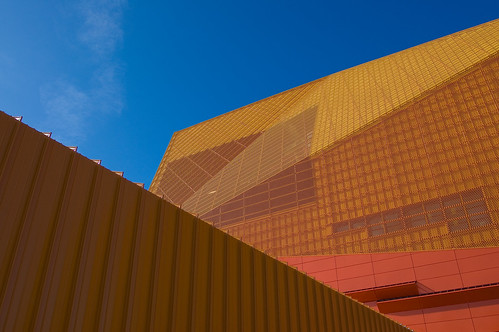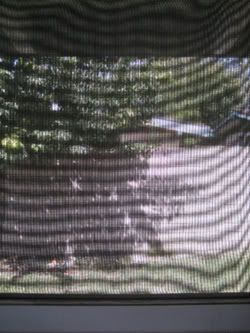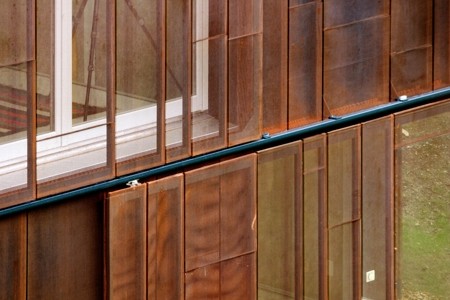i am hoping to create a moire effect that would involve two systems of overlapping louvers, one tilted at a small angle.
movement would be involved as well, either rotation of the louvers to create alternative opacities/densities or lateral shifting.
i am interested in knowing what the copious amount of information the collective minds of archinect posses can provide in terms of moire effects (intentional, and involving movement would be great).
thanks everyone!
ps: the design is still in its conceptual phase, so tangents are welcomed!
unintentional - i have screens on my windows with exterior shades (facing west, passive solar technique to reduce heat gain) and it's moiré-ing like crazy! i don't like :(
This is an animated example of a band moire for a project that never met reality. http://www.youtube.com/watch?v=pQqFNWVbOT0 .The sister project used animation to forecast the moire effects in custom cut panels before the client purchased them. This project was built. http://www.youtube.com/watch?v=DowCvNIgZMY and it was pretty accurate to the rendering.
the trend for putting louvres or slats to create shadow patterns should be banned from the world. My eyes can't focus (at all) when I see the shadows, and it makes me so dizzy sometimes that I need to leave immediately. I'm not epileptic, but that's the closest sort of analogy I can make. When I see the shadow patterns, my eyes feel like they're going to explode, and I get an instant (though temporary) headache. Ack!
Also, something not widely known but worth mentioning is that the moire effect can -in some cases - trigger epileptic fits so should be used with caution. As a kid I had seen it used in shops here in the UK and had to rush my mum out of the store before she collapsed.
No...sorry. I mean real in the sense that a moire effect is actually occuring. If you take a single sheet of mesh with no moire effect and incorrectly downsample the image you can produce a moire effect in the image despite no effect existing in real life.
I dunno, the de Young museum effect is created from an image transposed (abstractly) into a perforation pattern, according to my readings of the building anyways. So I'm not sure it would qualify as an intentional interference pattern. It's actually what it looks like as far as I know.
Correct on the de Young -- the only moire would be if and where the perforated copper skin might cast its own shadow on a solid surface behind the screen. . .
Aug 5, 08 11:20 am ·
·
Block this user
Are you sure you want to block this user and hide all related comments throughout the site?
Archinect
This is your first comment on Archinect. Your comment will be visible once approved.
MOIRE EFFECT
so everyone knows what a moire effect is...
(in case you don't: http://en.wikipedia.org/wiki/Moir%C3%A9_pattern)
i am hoping to create a moire effect that would involve two systems of overlapping louvers, one tilted at a small angle.
movement would be involved as well, either rotation of the louvers to create alternative opacities/densities or lateral shifting.
i am interested in knowing what the copious amount of information the collective minds of archinect posses can provide in terms of moire effects (intentional, and involving movement would be great).
thanks everyone!
ps: the design is still in its conceptual phase, so tangents are welcomed!
unintentional - i have screens on my windows with exterior shades (facing west, passive solar technique to reduce heat gain) and it's moiré-ing like crazy! i don't like :(
Reiser & Umemoto did a project involving the moire effect:





A competition entry for the New Museum of Contemporary Art.
The museum passed in favor of the "hell yes" sign...
hdem's rossetti pharmaceutical building has one of the more intense moire effects i've seen, screen printed glass over perforated metal:







some more on my poor excuse for a flickr page
nagaishi's work uses the moire quite a bit also, in their burberry store:
and in their louis vuitton store:
louis must like the moire thing because jun aoki's design for the store in roppongi hills does something similar with a different pattern:
also probably the best example, M3 Architects' Brisbane Girls Grammar School:


ok a couple more, i really need to complete my thoughts before i post;



Holl's Woningbouwvereniging Het Oosten
Feilden Clegg Bradley's London Centre for Nanotechnology:
loos architects



UN studio, teatro agora
h&dem's de youg
and my window:

i'm so cutting edge! right there with the big boys ..
OMA's mccormick centre has some visual trickiness that really effed with my head when the sun was shining...








h&dem, walker art center
kramm + striggl, expohaus
sanaa, new museum
david macullo
Lands Architetture, una boite moiree
wandel hofer lorch, jewish centre, muenchen
and a variation:
tivoli gardens
Hi holz,
I want your brain.
Thanks,
n_
nah, it's mostly worthless.



chipperfield, des moines library
make sure you carry that detail on down... like these sweet light fixtures
kuromata's how high the moon chair
here is that light fixture

This is an animated example of a band moire for a project that never met reality. http://www.youtube.com/watch?v=pQqFNWVbOT0 .The sister project used animation to forecast the moire effects in custom cut panels before the client purchased them. This project was built. http://www.youtube.com/watch?v=DowCvNIgZMY and it was pretty accurate to the rendering.
holz you make the rest of us look bad.
the trend for putting louvres or slats to create shadow patterns should be banned from the world. My eyes can't focus (at all) when I see the shadows, and it makes me so dizzy sometimes that I need to leave immediately. I'm not epileptic, but that's the closest sort of analogy I can make. When I see the shadow patterns, my eyes feel like they're going to explode, and I get an instant (though temporary) headache. Ack!
I'm wondering how many of these are real moire patterns and how many are just poorly compressed images of mesh.
Also, something not widely known but worth mentioning is that the moire effect can -in some cases - trigger epileptic fits so should be used with caution. As a kid I had seen it used in shops here in the UK and had to rush my mum out of the store before she collapsed.
by real do you mean mathematically correct somehow?
No...sorry. I mean real in the sense that a moire effect is actually occuring. If you take a single sheet of mesh with no moire effect and incorrectly downsample the image you can produce a moire effect in the image despite no effect existing in real life.
I dunno, the de Young museum effect is created from an image transposed (abstractly) into a perforation pattern, according to my readings of the building anyways. So I'm not sure it would qualify as an intentional interference pattern. It's actually what it looks like as far as I know.
maybe i AM epileptic. Who knew? Thanks archinect.
Just tried rendering a moire mesh in Maxwell (2"x4" Slats, one group rotated 5 deg from the other) and it crashed my Maxwell, just a heads up.
Correct on the de Young -- the only moire would be if and where the perforated copper skin might cast its own shadow on a solid surface behind the screen. . .
Block this user
Are you sure you want to block this user and hide all related comments throughout the site?
Archinect
This is your first comment on Archinect. Your comment will be visible once approved.